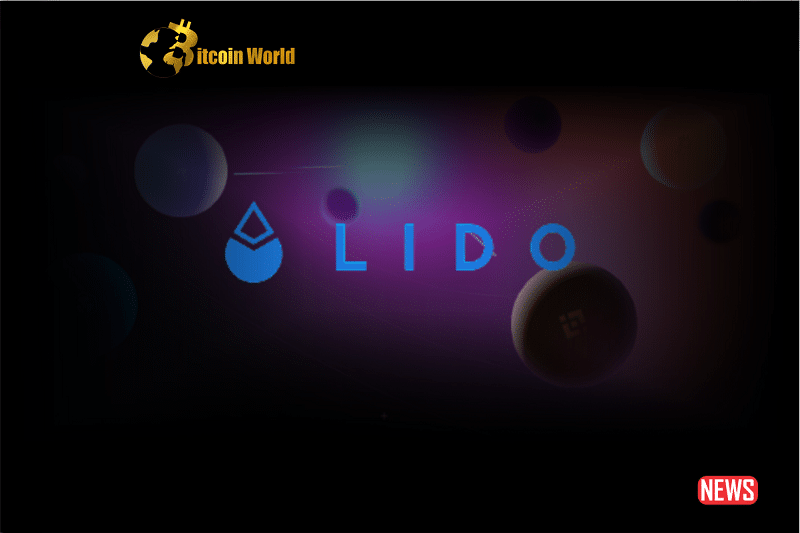The cryptocurrency market is rarely a smooth ride, and even leading platforms like Lido Finance (LDO) aren’t immune to the bumps. Recently, LDO experienced a dip of 18.94%. But beneath the surface of market volatility, some intriguing trends are emerging within the Lido ecosystem, painting a picture of both challenges and potential growth. Let’s dive into what’s been happening.
The Ethereum Beacon Chain Beckons: A Surge in Deposits
Despite the price fluctuations, there’s a clear sign of growing confidence in Ethereum staking through Lido. According to data wizards at Dune Analytics, deposits on the Ethereum Beacon Chain via Lido have seen a significant jump, reaching a whopping 112,500 ETH. Think of the Beacon Chain as the command center for Ethereum’s stakers – it coordinates everything before those stakers get to work validating transactions. This surge in deposits underscores the increasing demand for staked Ether (stETH) transactions, Lido’s popular liquid staking derivative.
Why is this significant? It highlights Lido’s strong position in the liquid staking arena, even outperforming competitors like Rocket Pool (RPL) in terms of deposit volume. It suggests that users are finding value and trust in Lido’s approach to staking.
Withdrawals and TVL: A Temporary Setback?
Market uncertainty can understandably lead to some users wanting to pull back their assets. We’ve seen this with Lido, where approximately 57,937 ETH has been requested for withdrawal, with 53,876 ETH already successfully claimed. This activity has naturally impacted Lido’s Total Value Locked (TVL), a key metric reflecting the protocol’s overall health and liquidity.
The TVL experienced a 2.09% decrease over a recent seven-day period. While this might sound concerning, it’s important to view it in the context of broader market unrest. It could indicate a temporary liquidity squeeze as some investors sought potentially higher yields elsewhere.
Can Lido’s TVL Bounce Back? Signs of Resilience Emerge
Here’s where the story gets interesting. Despite the TVL dip, Lido’s value actually surged to $12.76 billion. This suggests renewed interest and a belief in the platform’s long-term potential. However, the LDO token itself is still navigating choppy waters, experiencing a 2.17% decrease in the last 24 hours. This highlights the ongoing work needed to fully regain market confidence in the LDO token.
Liquidity Pools and Layer-Two: Where’s the Activity?
Let’s peek into the activity within different liquidity pools (LPs) and the bridging from Layer-Two (L2) solutions:
- Curve Finance (CRV): The ETH/stETH rate in the Curve pool saw a slight average decrease of 5%. This could indicate some selling pressure on stETH within this particular pool.
- Aave V2: Interestingly, LidoStETH deposits on Aave V2 increased by 7.45%. This points to continued user engagement and the utility of stETH within decentralized lending platforms.
- Layer-Two Bridges (Polygon, Optimism, Arbitrum): The rate of bridging assets from L2 projects like Polygon (MATIC), Optimism (OP), and Arbitrum (ARB) grew by 5.58%. This demonstrates the growing interconnectedness of the Ethereum ecosystem and the demand for staking opportunities across different layers.
These mixed results suggest a dynamic environment where different parts of the Lido ecosystem are reacting to market conditions in various ways.
What Does the Future Hold for Lido Finance?
Short-term market fluctuations are a part of the crypto landscape. The real question is: what about Lido’s long-term prospects? Several key factors will determine its future success:
- Network Adoption: As Ethereum continues to grow and evolve, the demand for staking services is likely to increase. Lido’s established position gives it a strong advantage.
- User Activity: Maintaining and growing a vibrant user base is crucial. The increasing deposits on the Beacon Chain and activity in Aave V2 are positive signs.
- Growth of the Ethereum Staking Sector: The overall health and expansion of the Ethereum staking market will directly benefit Lido.
Key Challenges for Lido:
- Addressing Liquidity Concerns: Ensuring smooth and efficient withdrawals is vital for user confidence.
- Maintaining Decentralization: As a dominant player, Lido needs to actively work towards decentralization to mitigate potential risks.
- Adapting to Market Conditions: The crypto market is constantly changing, and Lido needs to be agile and innovative to stay ahead.
Lido Finance: Weathering the Storm and Building for the Future
Despite the recent market turbulence and a dip in LDO’s value and TVL, Lido Finance has shown resilience. The surge in deposits on the Ethereum Beacon Chain, increased bridging activity from L2 projects, and continued engagement in liquidity pools offer compelling evidence of its enduring potential.
While challenges remain, Lido’s commitment to network adoption, user engagement, and fostering sustainable growth within the Ethereum staking sector positions it as a key player in the evolving DeFi landscape. The journey may have its ups and downs, but the underlying demand for liquid staking and Lido’s strong foundation suggest a promising future.
Disclaimer: The information provided is not trading advice, Bitcoinworld.co.in holds no liability for any investments made based on the information provided on this page. We strongly recommend independent research and/or consultation with a qualified professional before making any investment decisions.


